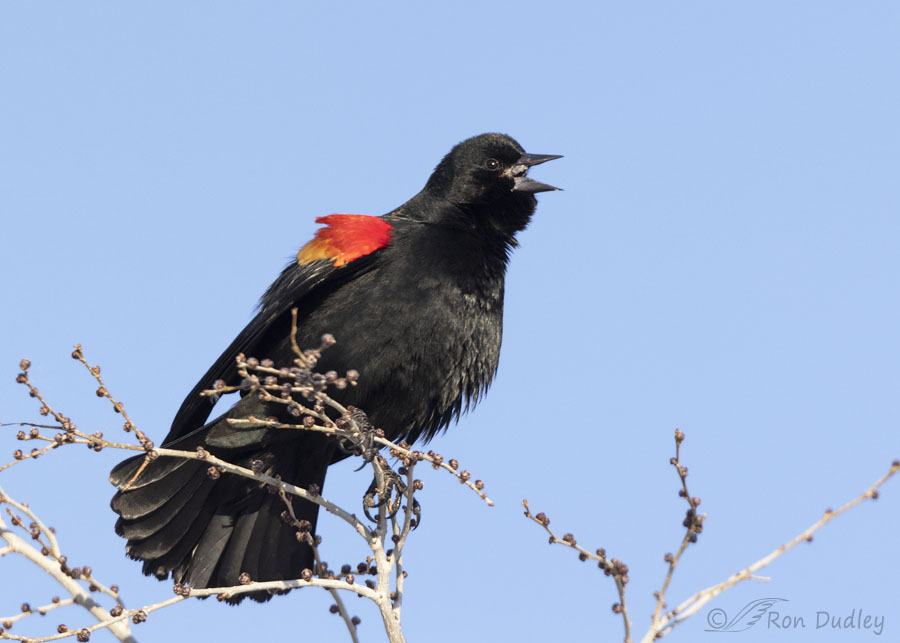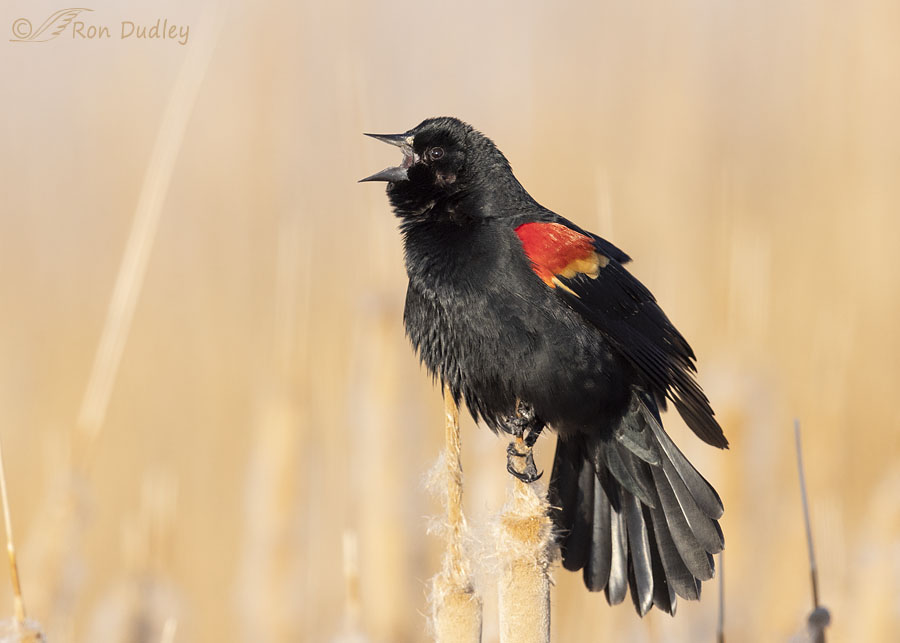Two days ago the behavior of male Red-winged Blackbirds at Farmington Bay WMA changed suddenly and dramatically. Compared to the day before it was almost like someone flipped a switch.
Red-winged Blackbirds are year-round residents of northern Utah and during winter the males sing (call) rather unenthusiastically when they sing at all. During winter their singing is not accompanied by the distinctive visual display of the males that is so conspicuous during breeding season. And since the males aren’t singing on territory they’re typically difficult to approach.
But during the breeding season, which begins early for them, their singing becomes much more enthusiastic and persistent and it’s accompanied by the highly conspicuous “Song Spread visual display” the males are so well-known for.
While I was at Farmington Bay WMA three mornings ago (Jan 31) the males were still in pre-breeding season mode. Their singing was unenthusiastic, not a single time did I see a visual display and they were very skittish and difficult to approach. Even though I tried repeatedly I never got close enough to a blackbird, singing or not, for decent photos.
But 24 hours later, on the morning of Feb 1, all that had changed.

1/3200, f/5.6, ISO 800, Canon R5, Canon EF500mm f/4L IS II USM + 1.4 tc, not baited, set up or called in
Many of the males were persistently singing on territory, they were displaying and they were easy to approach. Of the five times I attempted to approach a singing and displaying male I never spooked a single one. In 4 of the 5 cases I left the bird before he left me. The 5th bird was chased off by another male blackbird.
This one was singing and displaying atop a tree near the entrance to the refuge.

1/4000, f/6.3, ISO 800, Canon R5, Canon EF500mm f/4L IS II USM + 1.4 tc, not baited, set up or called in
And I found this guy singing and displaying on the grounds of the Eccles Wildlife Education center, adjacent to the refuge proper.
Males arrive on and establish breeding territories before females show up and I’ve yet to notice females so I believe the males are displaying as they attempt to establish territories. These behaviors should pick up dramatically as soon as the females arrive at the breeding sites.
I’m looking forward to it, especially after a brutal winter like we’ve been having.
Ron
Note:
Bird behaviors can be influenced by weather so some readers may wonder if the behavioral differences I noticed were due to the second day being nice spring-like weather and the first day being more winter-like. But weather-wise, these two mornings were darn close to identical. Skies were sunny, temps were in the teens and there was no wind to speak of on both mornings.
.


Great photos – thank you for sharing your observations! I am in Rochester, NY and our red-winged Blackbird males began signing their spring tunes yesterday. We’ve not had much of a winter-many above average temperature days and historically low snowfall (we’ve had more rain than snow sadly)…Seems an early spring is in order!
Great shots, but Not words a rehabber cares to hear. If we could stretch out winter and compress the “baby season” we would.
Onward and Upward!
What a treat! Love their epaulets! Haven’t seen any around here for a while; I wonder if the other Corvids have chased them off.
I DID see snow in Las Vegas over the weekend, though. Way north of The Strip (p’tooey) and wasn’t enough to even call it flurries, but there were definitely snowflakes and frozen boogers! I don’t miss shoveling sidewalks or digging my car out of the snow and ice, but I do miss a good winter. ❄️
Marty, I’ve seen snow on the ground in Vegas but only once. Daughter Shannon lives there and she says it’s been quite cold, for them.
Eugene, Oregon: Just a weekend ago I noticed that the male Lesser Goldfinches at my backyard feeder were suddenly sporting a dramatic color change, from dull winter ho-hum olive-yellow waistcoats and sleeves, to crayola yellow! Seems early. And females did not look impressed… just yet!
Spring’s a ‘coming.
How amazing. Reading through the comments I am wondering what it is that flips that switch, but it must have put a HUGE smile on your dial.
I think it did, EC – especially because it was such a surprise.
I can hardly think of Red-winged Blackbirds without picturing them among cattails with the instantly recognizable call of the male.
One wonders what triggered the switch to breeding behavior. Surely it’s not the temperature there. Florida and Utah must have something else in common.
“Florida and Utah must have something else in common”
We do, Lyle. Politicians that are bats*** crazy. Though I doubt birds are influenced much by that.
When I tried to get shots of these beauties last week, they were as skittish as could be. Unfortunately, we don’t have many here on the coast. Sure sounds like an excuse to go on a little road trip.
Catherine, I haven’t been able to get any decent shots of them all winter. Then, two days ago, everything changed and I got lots of them.
What glorious color displays in both the birds and the photographs ! Those
2 images could make a nice side-by-side display; the blue sky background
in the first complements the light warm ochre background in the second, and
the birds face “in” toward each other– you’ve brought us “spring” already !
Kris, truth be told I “flipped” that first photo so the bird was facing right instead of left. For the variety… 🙂
One of my favorites Ron. Nice shots of the singers. We have flocks of them close by at Willow Lake. 1.3 miles for me to drive down, but for them to reach out backyard probably a half mile at best. As a result we often get a few visiting our insect suet feeder outback. More often females than males, but we do get both. The noise when they all come together in the spring is really something to hear.
Thanks, Everett. They come to my seed feeders too, but only sporadically and in small numbers.
Interesting – I was thinking day length but Ken kind of shot that out of the water. 😉
Judy, who knows. Length of day may also have some influence over the timing.
A male bluebird was checking out the nest box yesterday. Wayyy too early! That is to say, for me. I usually check in early March to see if it needs cleaning out.
Looks like you need to get into nest box-cleaning mode, Sallie!
In south Florida they all disappeared in early autumn and the males returned to set up territory at about the same time of year as you are seeing in Utah. Interesting that they seem to synchronize despite the different latitudes and length of daylight. During winter the males and females congregate in flocks near the coast and also in agricultural areas.
Interesting indeed, Ken. Gotta admit, that surprises me.